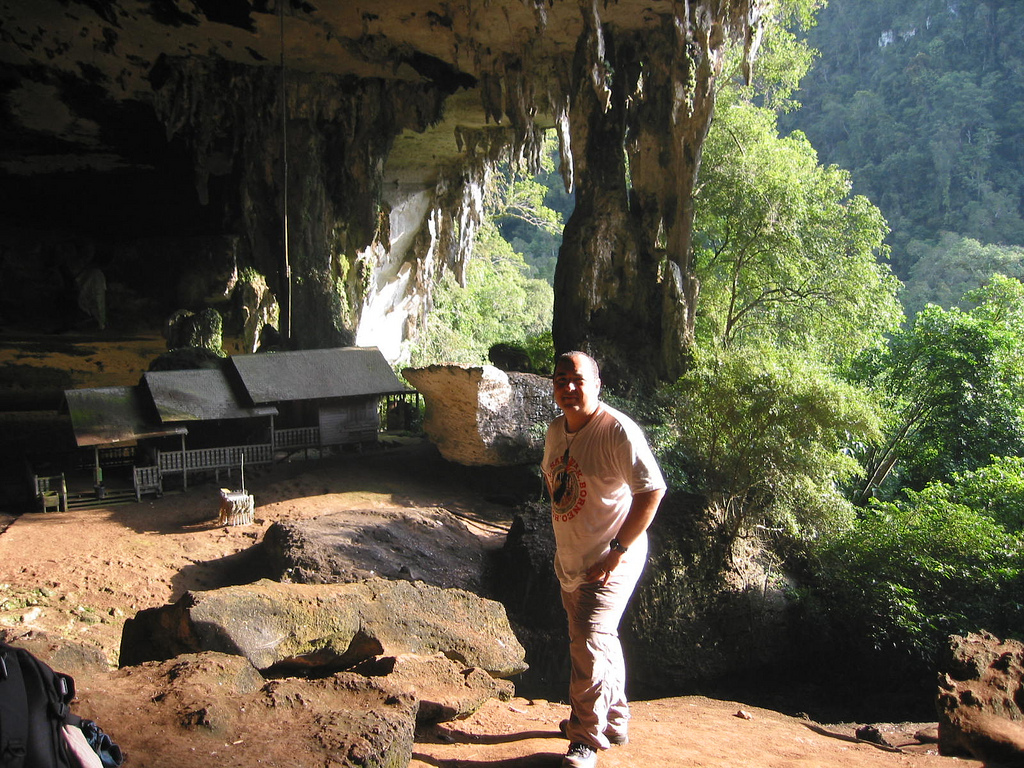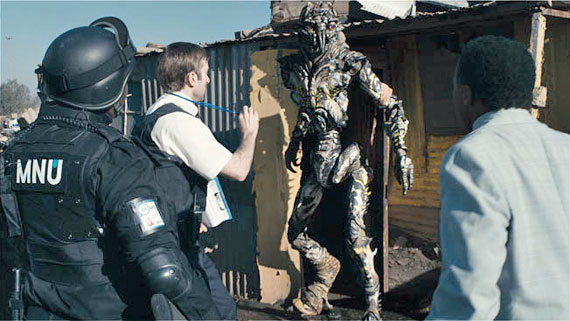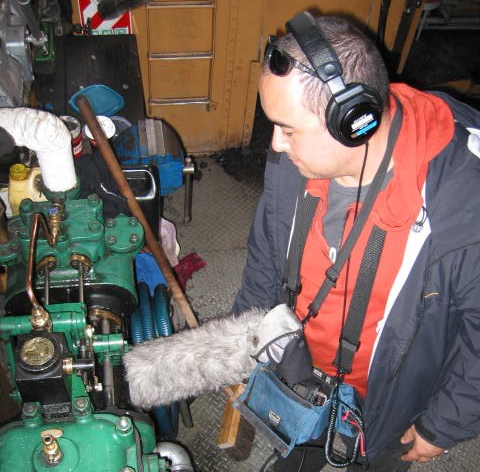
District 9 was one of my favourite films of this year, an amazing story, outstanding visual effects, and really great sound design, by Dave Whitehead, new zealand sound designer with more than 15 years in the Industry. I have a nice talk with Dave about the sound of the film, the sound effects, the alien’s language and more, don’t miss it!
Designing Sound: First of all tell us some about your career. How and when did you getstarted with sound design?
Dave Whitehead: I was offered a job in 1990 at the University of Waikato Music Department, running a small MIDI/recording studio. My job was to figure out how to use all the gear they would buy and then help student’s record compositions for their assignments. It was incredibly fertile ground and I was very fortunate at the time.
My boss at the time Professor Ian Whalley, had me compose music for the campus television production company. He also allowed me to record local bands and do the sound and music for student’s short films.
I worked on many short films and theatre productions before being offered my first feature film. It was a horror thriller called ‘The Ugly” and I was credited as sound designer. It was a definite crash course in sound post production and design. There was certainly a bit of sound library milking in the early days, but I did my best at the time to manipulate sound to create something unique. Through that process I learnt the importance in recording a fresh palette for every film.
DS: I can see that you are working on other projects with Peter Jackson… How is your relationship with him? How did you become involved with District 9?
DW: Peter is a driving force in the New Zealand film industry and he has an incredibly good ear for sound. He is always fantastic at articulating his minds ear and appreciates what we as a team bring to the table. I think most people who have the privilege of working with him would say any “relationship” would be one of respect for him.
We were all based at Park Road Post and we had just come off ‘The Lovely Bones’. The sound team down here in Wellington was primed and ready to move onto the next film. Fortunately for us, it was ‘District 9’.
DS: How was the communication with the director and the rest of the team?
DW: It was absolutely brilliant. Neill Blomkamp made himself available to us on any given day. He was fully open to experimentation and gave insightful and focused briefs. He really did know what he wanted, and enjoyed happy sound surprises from us too.
Supervising Effects Editor, Brent Burge and I discussed what needed to be done and he mapped out who was going to do what. My job was to come up with the alien technology palette and the language. The rest of the team new exactly what they had to do so the process of moving toward predubs was very smooth.

DS: How the concept of the film affect your decisions as sound designer?
DW: Initially on seeing the artwork I started building a very hi-tech palette for the alien technology. The Exo Suit is the classic example. We had an intensive record at a New Zealand Air Force base for hydraulics and all kinds of servos and tech devices. Version one was definitely more classic blockbuster sci-fi. Neill reviewed it and said he wanted it to be far more grungy, more real. He wanted it to be based on real world sounds, but with an alien core. So my concept took a 180° turn and I started on a new palette.
Neill also said the aliens were insect like and that their social structure was very hive like. The decision to record as many insects as I could was an easy one and the concept became one of the keystones to the design.
One of the major concepts was the lo-fi treatment in the security cameras. It was decided early in the piece that this would be done on the stage by re-recording mixers Mike Hedges and Gilbert Lake. That way they could control the amount and type of futz that was used in the final.
DS: Which were your main tools/processes for recording, edit and design sounds?
DW: I use a Sound Devices 722 and Sennheiser 8050s and 8020s, DPA 4060s, contact mics and range of other goodies to record. We do record extensively for every project. I use ProTools to edit and have Genelec monitoring. Some of my main plugins or tools for this job were Altiverb, Sound Toys, Antares Avox 2, various Waves plugs, Metasynth and my trusty old Roland JP8080 synth.
DS: What are some of the sources of that sounds? Can you give us some examples?
DW: I thought I would record insects at 192k to see what they had to offer the alien palette. I made a little insect recording booth and recorded bumble bees. Its amazing what interesting textures you can get from micro recording.
Also some of the guys decided to breed flies at the back of the studio to build up our ambient fly and close up single fly palette. After the rotten piece of chicken was devoured by the maggots that took up camp, they were given I nice glass tank to complete their transformation. We ended up with hundreds of them and released in the ADR room at Park Road Post. We recorded various intensities of flies, single fly bys and intense close up group buzzing and droning. It was disgusting but incredibly funny. Did I mention disgusting? We made some great ambient sci-fi components out of this stuff.

DS: One of my favorites sounds of D9 are definitely the alien vocalizations. You have the credits for that, so, how was that process?
DW: Initially they were more mammalian than humanoid. I was running on the concept of how sea mammals communicate, echo location and clicks. This also worked with the insect concept. Problem was it just didn’t sound enough like a language. It became obvious that the source of this needed to be an actual language, so I created one.
The language has hundreds of words so far and the assistant who typed it up for me and I could speak quite a few words to each other by the end. I recorded my voice for each character then replaced all of the consonants for every word with a palette I built. Then I started to replace vowels with various treated animal recordings and squeaks, creaks, breaths and groans from vegetable rubbing recordings. Vegetables can be quite expressive in the right hands. The fast purr like clicks in between their speech, were more of an alien thinking sound or a version of our “hmmm..”. That was a definite signature sound for me.
There would be about 10% human vocal in the finished alien voice. I premixed the consonants and the vowels as two separate components. We leaned a little more on the consonants, which gave it the more of an insect like feel.
DS: There are a lot of different futuristic guns in the movie, I think it was very fun for you to create them. How was that?
DW: In the first weeks before animation turned up I developed a palette of alien gun/weapon components. Bees, pipe hits and blows, nail guns and synthesizers through effects chains were some of the building blocks for the alien side of the weapons. I handed this palette to Brent Burge who cut the final version of the alien weapons. He definitely put the big boom boom in the guns.
DS: I felt some scenes of hard tension, “slow motion” moments, camera-falls, etc… How were the sound-decisions in these scenes?
DW: This was partly driven by the picture editors choice of temp sound effects. They worked so well, we created our own version and expanded on it. Kind of a seventies sci-fi, lo-fi feel to it. I made up a an ethereal palette for the film, but I used a very minimal palette for the Wikus ‘headspace’ scenes in the end.
When he gets taken the MNU laboratory we took it a step further with the ethereal design and background lab test animals and aliens. Lots of hard cuts and grungy unsettling shifts.
DS: How was the creation of the sound of the Wikus robot and Alien spaceships?
DW: The Exo Suit ended up being made from some very lo-tech elements. Typewriters, small appliance servos, dirt hits, steam train chugs to name but a few elements. I cut the first full version and handed it off to Effects Editor Hayden Collow, for the final hard effects sweetening pass to take it to the mix.
The core of the spaceships came quite easily. I sat down one morning in front of my JP8080 synth and a few excessive plugin chains and recorded one fat file that was the basis of the Mothership and the Dropship. I wanted a ‘heavy metal’ version of a spaceship and feel that’s what we got.

DS: The visual effects on the movie were incredible. Did you feel more commitment to create the sounds for that? Wich visual effects or scenes were more difficult to give sound?
DW: The entire crew loved the film from the beginning and the outstanding quality of the VFX was really just the cherry on the top of an already fantastic experience. I think It makes it easier to focus sounds onto the screen if the VFX are more realistic anyway.
The moving Mothership was difficult in the sense that it was HUGE and in reality you would have heard it non stop. So trying to figure out where and how to keep its presence in the mix without driving the audience nuts was a good puzzle. Gilbert Lake did a fantastic job of mixing that in.
DS: One of the things that most people talk about the film is the production cost, which was “cheap”. How did this affect the sound making?
DW: We had a very tight schedule, but I think sometimes on longer schedules we have the tendency to over think films. This was definitely a ‘design the sound for this moment quickly and move on’ situation. For me personally it was Rock and Roll film making at its very best! That’s not to say that I don’t enjoy working on films for extended periods of time!! Of course.
DS: Finally, tell us some about your future projects…
DW: As I said earlier we finished ‘The Lovely Bones’ and I am very proud of our work in that film, but we’ll wait to see what the punters think. I also just finished Supervising a New Zealand Feature called ‘Matariki’ which was a lot of fun.
There are several big productions coming up here in New Zealand, but one cannot speculate until the contract is signed. I’m working on some of my own music at the moment and trying to squeeze in some serious fishing until someone offers me a fantastic job I can’t refuse.
I’m very interested in designing sound for games sometime in the near future also. I’m open to any new challenges.
Dave Whitehead Website
DaveWhitehead at IMDb
District 9 Website
I love you’r work. What a great interview ;)
Good read.
Thnx for posting.
Same here! Brilian interview. I had so much fun watching this movie and was obsesed about the alien language sound design as well. I love this website btw, keep it up!
I enjoyed this interview too. I am Daves sister and learnt alot about the technicalities of what he does. Thanks for that. I can’t wait to see the movie.
Awesome Dave!! Great article. Very informative.
yeah…very awesome review..
[url=http://comunitate.pescarul.ro/members/bvndthyturee.aspx]scary movie metacafe nude scenes[/url]
Great interview, Dave is a great artist!
Oh you are awesome….what an amazing film…it changed my life, oh oh oh the sound….FUCK! love it!!!!